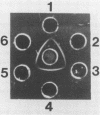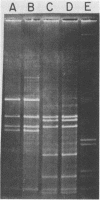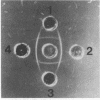Abstract
An exfoliatin B-producing strain of Staphylococcus aureus was isolated from two adults with typical staphylococcal scalded skin syndrome (SSSS). One patient developed desquamation after a local staphylococcal infection of the hand, and the other developed exfoliation after nosocomially acquired staphylococcal endocarditis. Neither patient was immunocompromised, had evidence of renal insufficiency, or manifested other potential risk factors for SSSS. Purified toxin, isolated from the causative organisms, produced a Nikolsky sign in neonatal mice. The toxins were shown to be exfoliatin B by biochemical and immunologic methods and heretofore had been described only in children with SSSS. Analysis of plasmid DNAs from both strains revealed a 23-megadalton plasmid with identical restriction endonuclease digestion fragments. One isolate belonged to phage group II (3B/3C/6/7/47/54/55), whereas the other isolate belonged to phage groups I and III (7/29/52/52A/53/54/80). The observation that a non-phage group II exfoliatin-producing strain of S. aureus may produce SSSS in adults indicates the need to better define the diagnostic criteria for SSSS. Immunocompetent adults may remain susceptible to some strains of exfoliatin B-producing S. aureus.
Full text
PDF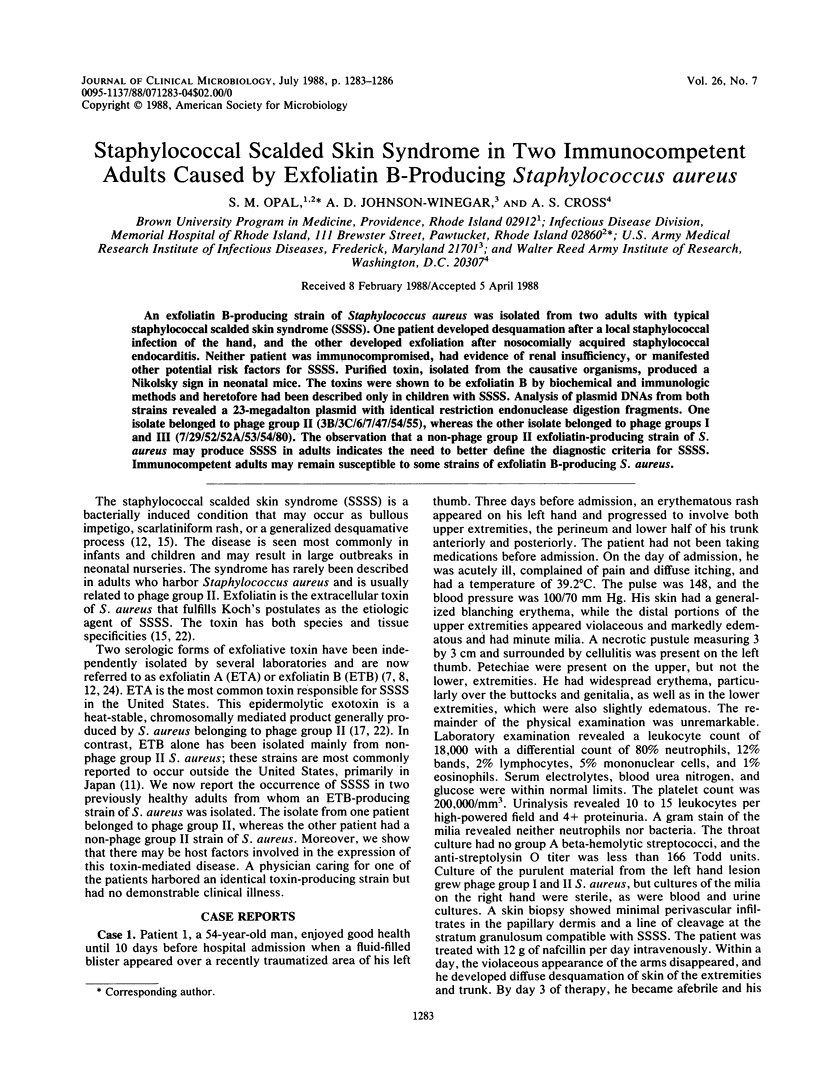
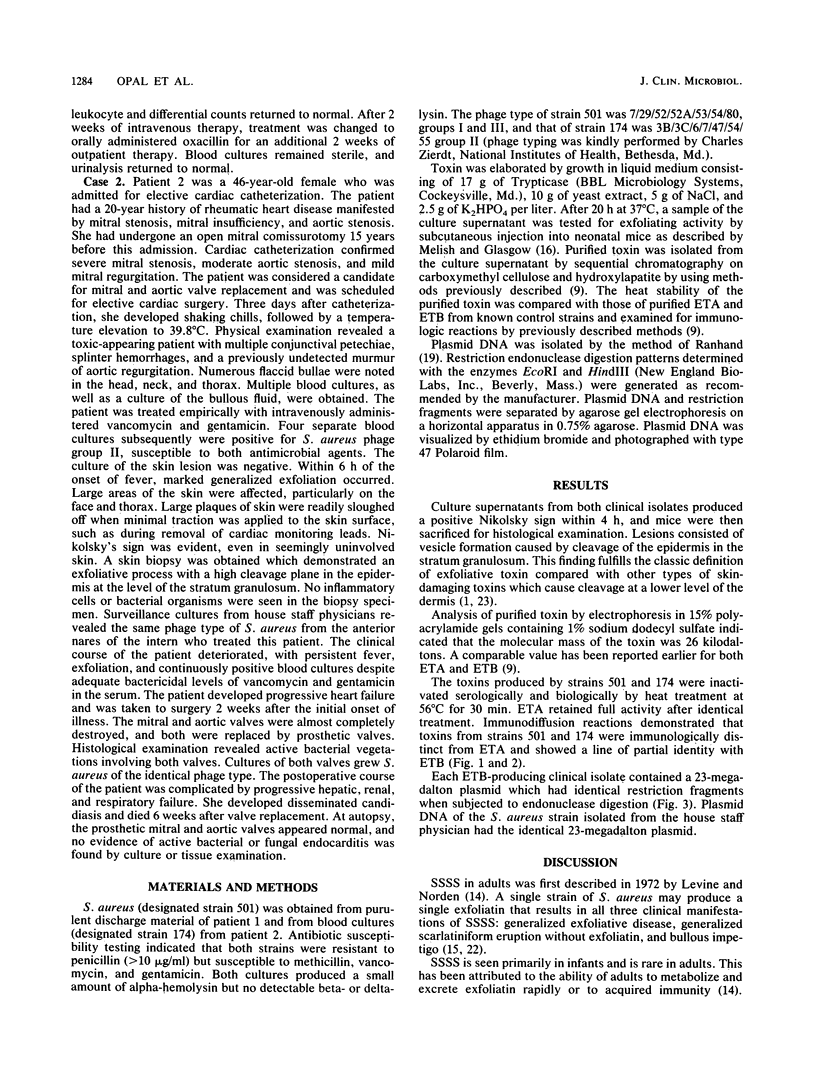
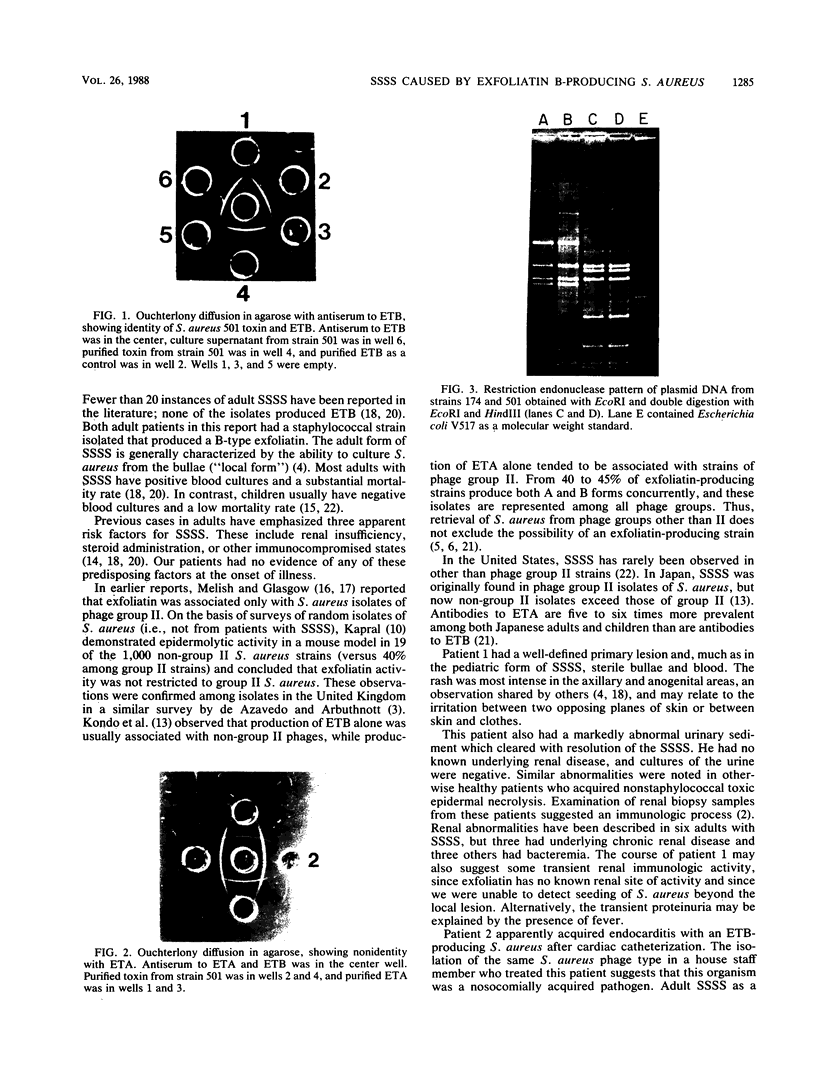
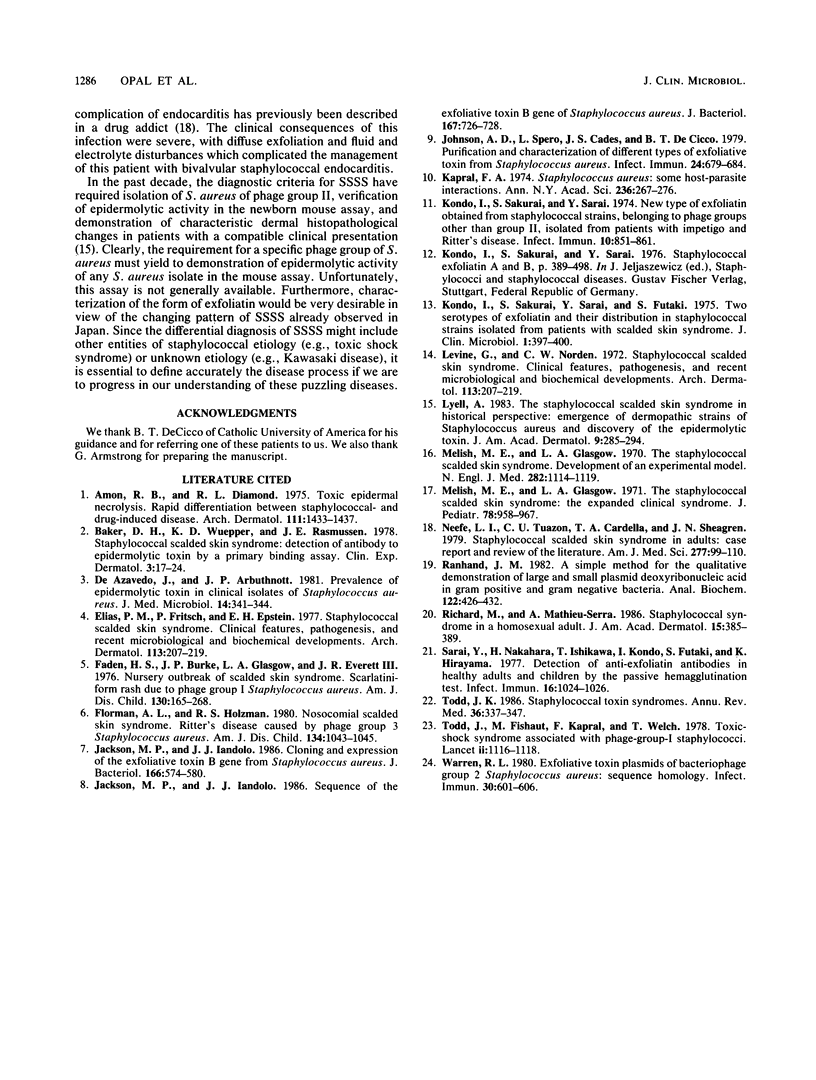
Images in this article
Selected References
These references are in PubMed. This may not be the complete list of references from this article.
- Amon R. B., Dimond R. L. Toxic epidermal necrolysis. Rapid differentiation between staphylococcal- and drug-induced disease. Arch Dermatol. 1975 Nov;111(11):1433–1437. doi: 10.1001/archderm.111.11.1433. [DOI] [PubMed] [Google Scholar]
- Baker D. H., Wuepper K. D., Rasmussen J. E. Staphylococcal scalded skin syndrome: detection of antibody to epidermolytic toxin by a primary binding assay. Clin Exp Dermatol. 1978 Mar;3(1):17–24. doi: 10.1111/j.1365-2230.1978.tb01453.x. [DOI] [PubMed] [Google Scholar]
- Elias P. M., Fritsch P., Epstein E. H. Staphylococcal scalded skin syndrome. Clinical features, pathogenesis, and recent microbiological and biochemical developments. Arch Dermatol. 1977 Feb;113(2):207–219. doi: 10.1001/archderm.113.2.207. [DOI] [PubMed] [Google Scholar]
- Faden H. S., Burke J. P., Glasgow L. A., Everett J. R., 3rd Nursery outbreak of scalded-skin syndrome. Scarlatiniform rash due to phage group I Staphylococcus aureus. Am J Dis Child. 1976 Mar;130(3):265–268. doi: 10.1001/archpedi.1976.02120040043008. [DOI] [PubMed] [Google Scholar]
- Florman A. L., Holzman R. S. Nosocomial scalded skin syndrome. Ritter's disease caused by phage group 3 Staphylococcus aureus. Am J Dis Child. 1980 Nov;134(11):1043–1045. [PubMed] [Google Scholar]
- Jackson M. P., Iandolo J. J. Cloning and expression of the exfoliative toxin B gene from Staphylococcus aureus. J Bacteriol. 1986 May;166(2):574–580. doi: 10.1128/jb.166.2.574-580.1986. [DOI] [PMC free article] [PubMed] [Google Scholar]
- Jackson M. P., Iandolo J. J. Sequence of the exfoliative toxin B gene of Staphylococcus aureus. J Bacteriol. 1986 Aug;167(2):726–728. doi: 10.1128/jb.167.2.726-728.1986. [DOI] [PMC free article] [PubMed] [Google Scholar]
- Johnson A. D., Spero L., Cades J. S., de Cicco B. T. Purification and characterization of different types of exfoliative toxin from Staphylococcus aureus. Infect Immun. 1979 Jun;24(3):679–684. doi: 10.1128/iai.24.3.679-684.1979. [DOI] [PMC free article] [PubMed] [Google Scholar]
- Kapral F. A. Staphylococcus aureus: some host-parasite interactions. Ann N Y Acad Sci. 1974 Jul 31;236(0):267–276. doi: 10.1111/j.1749-6632.1974.tb41497.x. [DOI] [PubMed] [Google Scholar]
- Kondo I., Sakurai S., Sarai Y., Futaki S. Two serotypes of exfoliatin and their distribution in staphylococcal strains isolated from patients with scalded skin syndrome. J Clin Microbiol. 1975 May;1(5):397–400. doi: 10.1128/jcm.1.5.397-400.1975. [DOI] [PMC free article] [PubMed] [Google Scholar]
- Kondo I., Sakurai S., Sarai Y. New type of exfoliatin obtained from staphylococcal strains, belonging to phage groups other than group II, isolated from patients with impetigo and Ritter's disease. Infect Immun. 1974 Oct;10(4):851–861. doi: 10.1128/iai.10.4.851-861.1974. [DOI] [PMC free article] [PubMed] [Google Scholar]
- Lyell A. The staphylococcal scalded skin syndrome in historical perspective: emergence of dermopathic strains of Staphylococcus aureus and discovery of the epidermolytic toxin. A review of events up to 1970. J Am Acad Dermatol. 1983 Aug;9(2):285–294. doi: 10.1016/s0190-9622(83)80161-3. [DOI] [PubMed] [Google Scholar]
- Melish M. E., Glasgow L. A. Staphylococcal scalded skin syndrome: the expanded clinical syndrome. J Pediatr. 1971 Jun;78(6):958–967. doi: 10.1016/s0022-3476(71)80425-0. [DOI] [PubMed] [Google Scholar]
- Melish M. E., Glasgow L. A. The staphylococcal scalded-skin syndrome. N Engl J Med. 1970 May 14;282(20):1114–1119. doi: 10.1056/NEJM197005142822002. [DOI] [PubMed] [Google Scholar]
- Neefe L. I., Tuazon C. U., Cardella T. A., Sheagren J. N. Case report. Staphylococcal scalded skin syndrome in adults: case report and review of the literature. Am J Med Sci. 1979 Jan-Feb;277(1):99–110. doi: 10.1097/00000441-197901000-00013. [DOI] [PubMed] [Google Scholar]
- Ranhand J. M. A simple method for the qualitative demonstration of large and small plasmid deoxyribonucleic acids in gram-positive and gram-negative bacteria. Anal Biochem. 1982 May 15;122(2):426–432. doi: 10.1016/0003-2697(82)90305-0. [DOI] [PubMed] [Google Scholar]
- Richard M., Mathieu-Serra A. Staphylococcal scalded skin syndrome in a homosexual adult. J Am Acad Dermatol. 1986 Aug;15(2 Pt 2):385–389. doi: 10.1016/s0190-9622(86)70185-0. [DOI] [PubMed] [Google Scholar]
- Sarai Y., Nakahara H., Ishikawa T., Kondo I., Futaki S. Detection of anti-exfoliatin antibodies in healthy adults and children by the passive hemagglutination test. Infect Immun. 1977 Jun;16(3):1024–1026. doi: 10.1128/iai.16.3.1024-1026.1977. [DOI] [PMC free article] [PubMed] [Google Scholar]
- Todd J. K. Staphylococcal toxin syndromes. Annu Rev Med. 1985;36:337–347. doi: 10.1146/annurev.me.36.020185.002005. [DOI] [PubMed] [Google Scholar]
- Todd J., Fishaut M., Kapral F., Welch T. Toxic-shock syndrome associated with phage-group-I Staphylococci. Lancet. 1978 Nov 25;2(8100):1116–1118. doi: 10.1016/s0140-6736(78)92274-2. [DOI] [PubMed] [Google Scholar]
- Warren R. L. Exfoliative toxin plasmids of bacteriophage group 2 Staphylococcus aureus: sequence homology. Infect Immun. 1980 Nov;30(2):601–606. doi: 10.1128/iai.30.2.601-606.1980. [DOI] [PMC free article] [PubMed] [Google Scholar]
- de Azavedo J., Arbuthnott J. P. Prevalence of epidermolytic toxin in clinical isolates of Staphylococcus aureus. J Med Microbiol. 1981 Aug;14(3):341–344. doi: 10.1099/00222615-14-3-341. [DOI] [PubMed] [Google Scholar]



